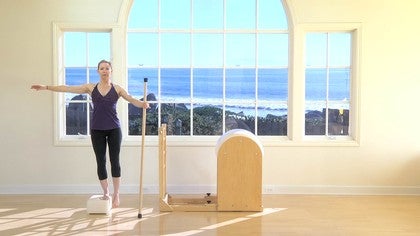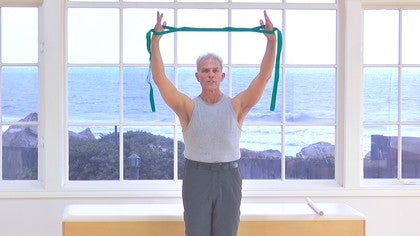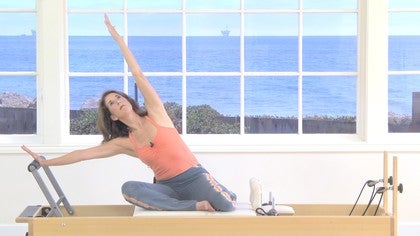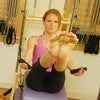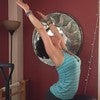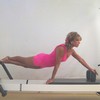Description
About This Video
Transcript
Read Full Transcript
This class, I'm calling a balance class and I personally worked on this class to help my own hip and knee, which started changing its strength and alignment due to a meniscus tear in my knee, which is asymptomatic now. Uh, and then I keep working the balance of my hip and my legs to help keep my legs strong. So this is, um, balanced class for you, Allah, to keep strength and you're standing leg. So the setup to start is a jump board if you don't have a jump or you could simply use the bar. It's just that the bar's a little lower than jump board. Uh, so it's nice to have the board. Um, we're going to start with a blue or red spring depending on your reformer. I probably recommend a red spring. And we're going to take the loop. Now I'm going to turn my back so that we're going to place the loop around the my right thigh, the leg closest to the riser, this and then what we want to do is pull the reformer away from the bumper, a few inches. You're going to feel a pull of your leg. And then what we need to do is feel the weight on the whole foot.
So the center of the heel, the big toe, and the little toe. We're going to work that tri point structure of the foot and try to balance on the foot. Press the inner thigh against the loot for that stability. So you're pressing the femur in towards the low and we're gonna unawake the front leg. Check the pelvis, see if we're level, keep your grounding through your big toe, hold it. And if you feel balanced, you can swing your leg back to touch the reformer and then come back up. And if you had more room, you could actually swing your leg back further.
And we'll take this five times or more. Now it doesn't look like I'm doing much, but my inner thigh is really working, pressing into the loop and I'm really grounding through my standing leg. Okay, now we're going to turn, bring the reformer back and I'm going to switch legs now and face the reformer. So again, we're going to pull the reformers. We've got the weight of the loop against the leg, ground the foot. And we're going to pick up the standing line, the other opposite leg onto the reformer. So now again, I'm feeling the inner part of my whole Femur, pushing in to the loop.
Very active. Try Point foot standing. Now here I can balance cause I have my foot here. Now I want the leg on the reformer to be very heavy. So just dangle your leg, heel comes off and try to unweight and hold. You're gonna notice is a difference usually between your right and left side. So just kind of wait and hold and then you can challenge yourself and hold for longer periods of time.
Each time. Keep breathing, relax the shoulders, see if you can just stand and be solid on that leg here. That's three.
Now I'm going to lower the leg down without touching the floor and I'm going to reach behind me. So now I have more room so I can reach further behind and I'm going to bring the knee forward and we're going to go back. So it's a little bit of a swing and forward and I'm still concentrating on my standing way. The activity, you can see the reformers moving slightly. Ideally I don't want any reformer movements. If you can keep the pressure, the legs getting fatigued. So keep working it and up. And then we're gonna place the foot down. One more with the loop.
We're going to turn this way. So this is going to be difficult. I can't see my lower leg when I go on the other side. You'll be able to see that better. I want the lower leg, the Tibia to be as vertical as possible. Do not let your knee bend back. So the Tibias back on an angle. So what I'm doing to prevent that is I'm keeping my weight on the big toe ball and the little toe ball and that centered the heel.
And at the same time I'm going to lean slightly into it. So by leaning I'm activating my leg. Now forward trying to keep the alignment of the Tibia and the femur forward. So because of the lean is a little bit more difficult to lift that leg. And then we're going to swing and we can swing our arms with it too, as if you're running in space without going anywhere.
It's kind of running here. I'm running along. If you're like, uh, maybe Charlie Chaplin or something, one of those movies. So he keep working at, you got to keep pulling up that Patella. So the quadrant
So I have room for the leg to swing. So try point inner thigh, pressing into the loop, lifting up on the inner leg and then swinging the leg can add arms. I sometimes like to hold my pelvis and I see I can losing my big toe so I got to get my weight back. So it's really important that instead of struggling and falling over that you, if you lose your contact of your foot, stop, renew the contact, hold it and then see if you can move without losing that contact of the foot and the activity of the inner leg. There you go. This is good. And just breathing, relaxing the shoulders, finding the balance and then down.
Good. Now we switched to the other leg. Okay, so now you'll notice the alignment through the Femur, down to the heel. We want to keep the Tibia vertical, standing leg on the carriage, hips, just relaxed but not sinking into the hip. And we're going to dangle the leg, the heel, hip drops, pressing actively into the strap and down and press and lift. And just breathing down and lift again. If you're losing your balance, just reorganize yourself. The more you practice, the more you'll be able to have better balance. Okay, one more time. Go ahead and put down.
Now we're gonna face the jump board. I'm gonna lean slightly into it and then I'm going to lift the leg up. I'm trying to keep that leg vertical and then swing. Just nice and easy. Breathing. Shoulders relaxed, being aware of your foot contact. And I'm starting to feel a little change in my foot, so I'm gonna reorganize my foot. Big Toe Ball.
I got to get forward a little more. There we go. Don't have to move fast. Our stabilizer muscles actually work better when we're moving more slowly. Okay, and rest. So that's a good way to challenge the whole leg and hip, waking up those stabilizing hip muscles.
So now we're going to come to the end of the board here. I'm going to take a wide stance with the feet slightly turned out not too far, and we're gonna use the bar if you need it. The board to balance or not. So what I'd like you to do is just to bend the knees. I'm going to go down not too deeply, but just enough to feel that rotation, the hip. And then I want you to, if you have to, hold on, you can bring your hands here.
Shift your weight over to one leg. Just bring your foot to your ankle. See if you can balance, come back, bend, shift your weight to the left leg. Just bring your foot to your ankle. See if you can [inaudible] imbalance and come back and bend to shift your weight over the leg. Come back, then shift your weight, let go, come back. And then perhaps you can do it without actually holding on at all and back and bend. Shift your weight balance down. And if you want to challenge yourself, you can shift your weight, bring your foot up higher towards your calf or your knee stances would call it.
It's a posse. And shift your weight maybe to the calf up to the knee and come back. I'll do two more times. And again, you can gently touch the board, let go and chat and balance yourself. Come back, then shift the weight,
Now what I want you to feel is the first thing you're gonna do is just bend your knees, only bend your knees. So try not to bend in the hip. It's a very tiny movement and you're gonna feel the hamstrings activating there. And then press the board away. Feel that tri point contact of your foot. Then the knees. Feel that hamstring engagement and push away.
Just find the length in one more time. Bend the knees and then we're going to bring it all the way in. But only to where your ankles stop. I don't want the heels to lift. We're going to push with the heels into the board and just push out and feel the knees and then the hips and push out. Concentrate knees, bending hips. Feel the heels. We're going to do five times. Reach Ben
I'm going to turn it out. Turn the heels out and come down. I'm gonna go a little bit wider. So take the stance a little wider. So we're going to go up. Turn the heels inward. They're going to touch. We're going to swing the heels outward and down. Press the heels up.
Now the turning is the whole leg rotating outward to the heels. Touch no change in the pelvis or the ribs. Now swing the heels out. You'll feel your sit bones widening as the heels swing out and up, and then draw them together, the heels and draw them out and down and up. Draw them in. Now we're going to go down with the heels. Lift heels out and down.
We're repeating up heels now. Heels down and lift and parallel. And let's do one more up. Turn it out, down, lift heels out, down. And now we're going to lift up to the small V. Place the heels down. Don't, we're just gonna bend here. Ben, press the heels into the board. Feel the length through the torso and then and feel the whole foot.
And then just five times stretch. And then, and stretch last one, Ben, and stretch with your, lift the heels up again. Bring the heels out all the way out so we're feeling a little rotation inward. And when a, drop the heels down and just go up in a turnout and turning in with the heels out and up
Now Peel your feet off, press your heels into the board, bring the feet down, lift the heels up, and then bend the knees and come in. That's the action we're going to repeat. Now I want to show you if you have a leg alignment that's a little more knocked knee. The leg together position doesn't work, so it's another option, which also feels very good. So I'll do both for you. So this going to take a block or you can take a, like you could take a sticky mat and roll it up and put it in between the thighs and we're going to push out. So the blocks facing down and the activity here is not to squeeze the block per se, but use it as a space hold. And then imagine that the block is moving towards the floor.
That's to straightened the lights. This is wrapping downward. All right, and then lift the heels up and then we're going to bend the knees in to start. So now we're going to push out and as you push out, you're going to feel activity against the block as a leg straighten. And now as the heels go down, feel the thighs rolling outward a little bit. The knees are still facing the ceiling. And then we're going to press into the heel, pulling the block down, putting the toes back, heels lifting, and bringing that block up towards the ceiling and out, down.
Press the heels down, lift the heels and bend in. I'm going to remove the block and do three more repetitions with the legs together. So keep going if you're doing it with the block, but with the legs together, if you're a little more bold legged, it actually challenges you to find that position of your leg spiraling outward. To keep those knees towards the ceiling works the inner thigh a little bit more. Heels down. Press into the heels, toes down, heels, lift and and, and push and drop. Press the heels, toes, heels. Then one more out, down, heels. Press up. Now we're going to stay up here and let's just do a little running in place.
Nice and easy. I know there's, you're meeting the floor, there's no bar to go under, but we're still able to get the lift, strengthening that posterior part. That's the back of the lower leg. Deep muscles of the calf beyond the calf, towards the bone. Great. And lift both up, heels down and bend the knees and come on in. Okay, good. I'm going to shift gears now. Give our lives a little bit of a break and we're going to do a little stretch for the lower back and start extending through the spine. So in addition to balance, we have to have a strong connection of the back into the pelvis and the arms, which is part of really improving standing well.
In order to stand well, we have to have the strength here in our back and that will give us a nice balance. Okay, so we're going to kneel, it's a little bit like a nice stretch for those of you who are familiar with the holidays repertory. But I'm going to use the board and I'm going to have my hands on the outside. And depending on where your bumper is, you're just going to have your pelvis flex back so you're in a neutral position with your back. And we're going to first do is stabilize in this position and you're gonna push the carriage out until your knees are right under your pelvis, not past, just right under. And then from here we're gonna extend through the arms. So you reach out and now your head is coming down through the length of your back. Your ears are going to be on either side of your arms, so not below.
And then lengthen, keep pushing back as much as you can. Inhale here and then as you exhale, start to curl. Try to keep pushing your feet back and curl the pelvis under you. The torso is going to come up, some your head's gonna drop and you don't have to come to the bumper. Come to a place where you feel like you've got most of your flection, and then roll your spine into neutral. So it's legs, length and out.
Keep the head between the arms, Linkedin as much as you can. Don't let the rib cage drop. Now. Keep the legs reaching back. As you're curling, you're creating a tension or resistance through the tissue. Let your head go and bring the body back up. Inhale and again, legs and reach back.
Keep extending it a little more length and curl. Keep reaching back through the heels. Curl, curl, curl, and come up to neutral. Okay, very nice. So we're going to do a stretch for the hip joint now. So we're going to come up to the board and I've found the board a little hard compared to my board at home. So I took a pad because I like to be comfortable. All right, so, um, if this is too high, you can use the bar cause it's a pretty high position. But we're going to bring the foot to this corner and I come up on my uh, heels just so I can get my leg to just kind of drop down.
Very tight here. As you can see, there's a distance here between here and here. All right. But I keep dropping the hip down. So what I'm going to do is I'm going to push my whole outer leg into the board. So it's just pushing down. So isometric, I'm just pressing, I'm going to hold for a count of five, three, two, one. And then I'm going to stop pushing and it'll keep my spine long and just kind of lean forward. I'm going to push again, push. So as I'm pushing, I'm feeling contraction, I'm feeling activity in my hip right here and I'm just breathing and holding that and then stop contracting.
And then I'm going to lean forward a little bit more. You might notice my leg is coming down closer to the board. And again I'm going to push into the board, activating those deep hip muscles. And then I'm relaxing and then allowing for forward bend. Stretch. Feels wonderful. Okay, now we're going to do the other side. So you saw how the, the distance, the space between the knee and the board changed.
So I like to come up onto my heel just so I can get my hip around. And you can see this hips a looser hip for me cause I'm down on the board just to start. So we're gonna press into the board, five counts, three, two, one and then relax. And then coming forward. And again, pressing three for [inaudible] and then relax. And then I'm going forward. And then do one more time and press two, three, four, five and then relax.
And then I'm going to lean forward. Nice stretch. Okay, one more motion with the board before we take it out. And one red spring is fine. We're going to kneel, we're going to do kind of as, so as spinal stretch here and a lot of you are familiar with this, but I want you to think about, we're going to concentrate on if your knee is down then this knee so that your pelvis is level. So if your, if your knee is down and leg is a little straight, can see your pelvis comes out of alignment. So just bend what you need to do here. And what we're going to do is as the foot goes back, we're bending in the hip here, the knee is going to stay right over the foot and I'm going to reach down. So I'm, my knee is sinking down into the reformer and sliding back at the same time.
This hip is dropping as well. Now from here I want you to use your arms on the board here and I want you to lift your sternum. Uh, so this part of your chest is going up. Sternums arising this way as my leg is going back. So I'm going up with the chest as my hip is opening and then I'm bringing it to bring it back in in a can curl a little bit here and I'm going to press back with the knee. So it's not, I feel like what I'm doing is pushing my weight into my knee a little bit and sliding back, reaching and then using the arms. I'm going to go up with the chest as I send the carriage back, but only as much as I can lift my chest up and then I'm gonna curl in one more time and I can go right into it. Now chess growing up, reaching through the arms, sending the leg back and the chest up, which at some point there's no more movement and cause I've gone to the end of the chest and, and leg. Oh, it feels great.
I feel a little bit long on that side. Okay, so here we go. So now I won't describe it as much. So we're gonna drop the knee down, see the chest growing up at the same time, breathing in and trying to lift the chest as much as the leg is going back. And then resisting the carrots slightly and curling in and back. Chest up,
The way we're going to kneel. So we're going to need a two pads, one pad for your knee and the other for your Shin because it's uncomfortable with the middle bar right here. So we're gonna do this. Okay. Now to get on carefully, because we're gonna be taking one leg in and putting it on the reformer. I don't want you to fall over. So we're gonna get your knee on here. Hold onto the reformer, bring the other leg up. Now get your big toe on the edge of the reformer here.
And then we're going to push out. Now let's make sure you feel balanced. Keep the knee bent. All right, and we're going to extend out right, and now bend the knee and as much as you can, we want to try to lift up the kneeling side. This pelvis bone, tried to lift it up as much as you can here and then you're gonna press it out. The work is deep in the hip here and press it out. So we're getting length through the ad doctor, attracting the deep hip muscles here, balancing through the core stretch. Keep lengthening out.
Now be careful that your standing knee are not shifting to the side. See how I just did that? Don't shift on the inside of that knee. You want to stay vertical with this leg. It's only this leg that's moving and that's important so you don't stress the knee that you're kneeling on and stable. We'll do total of 10 it's probably been about 10 and stretch and I like to do one little length here, stretching long into that hip and you didn't notice. I'm putting a little pressure right here with my hand. Feels very nice. Okay, let's do 10 on the other side.
We have to change the pad to protect the Shin on the metal bar. So we're going to kneel, use two hands to, to balance yourself. Placed your big toe on the edge of the carriage so you can hook it there and you can start bend, bring the standing hip up. You should feel your glute working on that side. And you're going to press out in lengthen.
The first couple might feel a little stiff, so don't push your knee. You don't have to fully straighten. But maybe after about three or four you could start to lengthen. Create some space in this hip. Keep breathing. Good. And six, that's some counting this time and seven
You want to make sure that we're sitting not too close to the edge. It should be one hands with here. Now let's just practice for sitting Nice and upright and as you've been, I want the elbows to stay exactly where they are and the upper arms staying horizontal to the floor so the hands have to go up, elbows reach forward and then you extend never dropping the elbows down. So here we go. Let's do ten one it can extend to keep the back nice and wide.
Bring the arms out to the side. Now the chest is going to come through and the arms are going to go behind you. I want the back long so don't round over. And then we're going to circle the arms, keeping the back nice and long until you come to the bumper. And when you finally hit the bumper, you can go ahead and relax your back down.
Don't pull, just relax and then roll up. And we pull again up lean elbows out, palms towards your chest, arms out to the side, chest comes through, straight back. Reach the arms behind you and then bring the arms circling to the side until you come to the bumper. And then at that point you can relax and just relax your body over. Don't push it, roll it up and Oh ling, elbows out. Hold it. There's your arms, go out to the side, reach, bring that chest through your arms behind you.
Pull nice straight back and circle. When you hit the bumper, go ahead and relax in. Rule it up. We'll do it one more time. Pull lean back. Maybe you go a little further this time and arms down out to the side. Bring your chest through and arms behind your trying to lengthen through the back, pulling through the reformer, circling the arms slowly and then relax and roll up to sit it. Excellent. It felt very good.
Nice stretch for all leg work that we did. Okay, so now we're going to grab the box and we're going to place it on the floor right next to the reformer and I think one red spring would be a good distance. All right, so this is a safe way of doing standing lunches and it's a good challenge again for your standing leg through movement. Similar to feeling to feeling of your leg. It's like when we had the strap on the legs. So we want to engage the leg and what we're going to do is we're going to bend the front knee as you press back and try to straighten the back knee here.
You don't have to completely straighten the knee. And Bandon, if you find it's pushing, you have the reformers pushing you too much, then change your spring to a lighter spring. But the point here is to try to find that lunge the knee over the ankle, nice hip flection with the resistance in the back and balancing through. And we can add a swing of the arm with a rotation of the chest so you can turn the chest and up and reach
And I'm gonna bend this leg and reach and come up standing leg. So I'm imagining I have that strap that I started with on my leg and I'm using that resistance through my leg to feel strong to stand on one leg. And you can just, I like playing with my arms. They can move and opposition. Sometimes moving them up is a challenge you can do. Some circles really can just play with your arms because if you don't think about exactly a certain pattern with your arms, it will actually challenge your balance because you're being unpredictable out of your pattern.
So I find that I like to play with just some motion or the balance there. Okay, so now we're going to go into our mermaid. I like the barn. Well, let's see, perhaps a little higher now sitting in this position, really a challenge for many of us. So the hip, the way of the hip dropping. Now with the knee, it tends to pull here on this inside of the knee, which is where I've had an issue. But I find the more that I sit here and try to work with my hip down, get that stretch. It actually relieves any kind of tension on the inside of that knee. So good.
Put your hand here, but if you have great discomfort, you know you can come out and just, you can actually sit like this or you could sit with your legs down. But this is the tradition is to sit this way. Alright, hands in front of the shoulder, arms straight, and we're going to push out and lengthen. Now I want you to think of length. Now instead of bending over the bar this way, see if you can lengthen both sides of your waist. So we're going to go up and lean. So I'm bending in the hip joint here and I'm lengthening from my hip through my fingertips, trying to find length.
Also here it's a very different feel. Inhale, exhale and length. Reach up
And then lengthening. You see every time I push I'm trying to find more length in my back. I'm going to stay out here, bring the right arm towards the center and twist the arm and the length in the body up and come back to center. Let's do the other side. You'll get it back. You.
Now come up to the length of the waist, both sides lengthening and then come back to center. Good. Now I'm going to practice. I'm sitting on the reformer to standing, which sounds pretty easy, but for some people that it's really not. So you can have your hands on your thighs to start. Now try not. We're going to lean forward a little bit.
We have to in order to get our weight onto our feet, but not too much. So right from if you can, we want to lift the pelvis up, up just standing and then from the hip. Let it sit. Bones widen, tailbone reaching back. Waist stays long and I'm going to sit back. Try not to let the knees come too far forward. All right, so we're going to go up standing.
Feel the sit bones go wide. Feel the tailbone, reach back, lengthening back, and sit. And again.
Mindful Movement: Returning from Injury
Comments
You need to be a subscriber to post a comment.
Please Log In or Create an Account to start your free trial.
